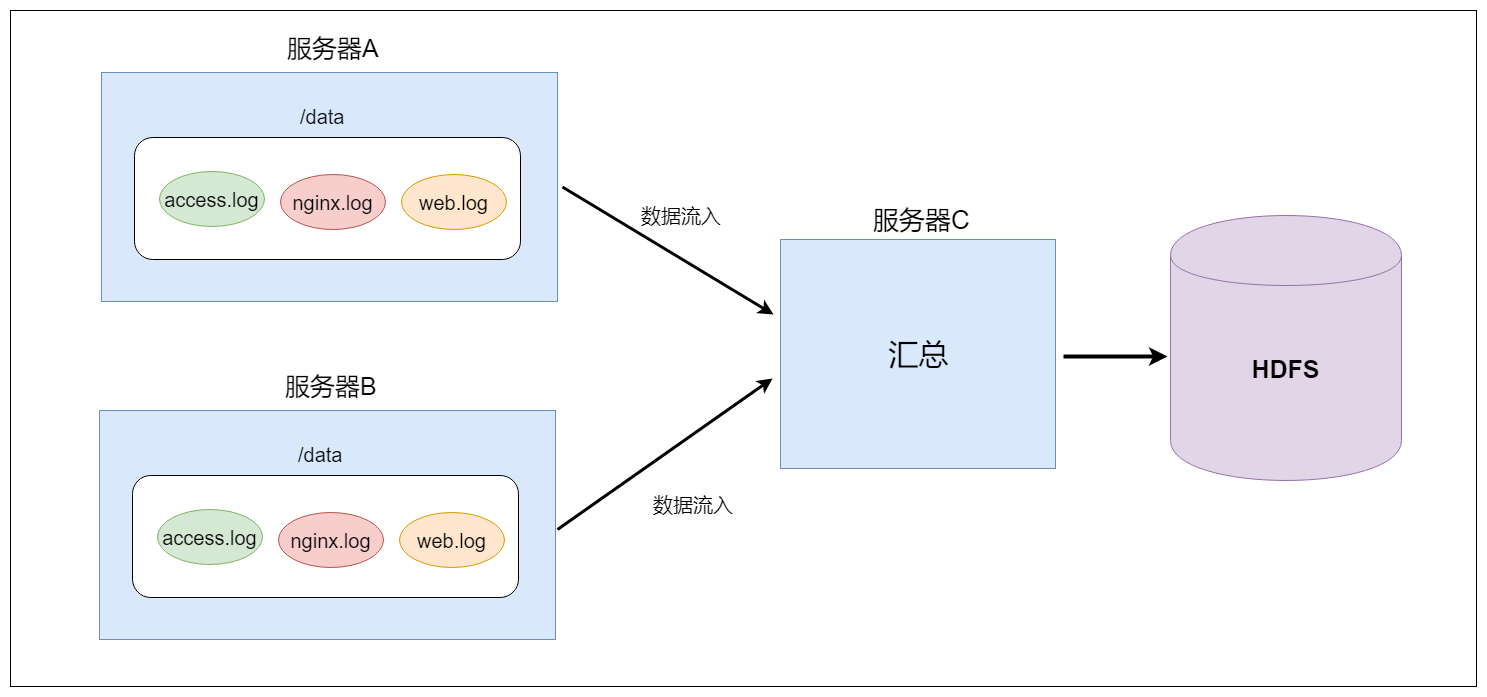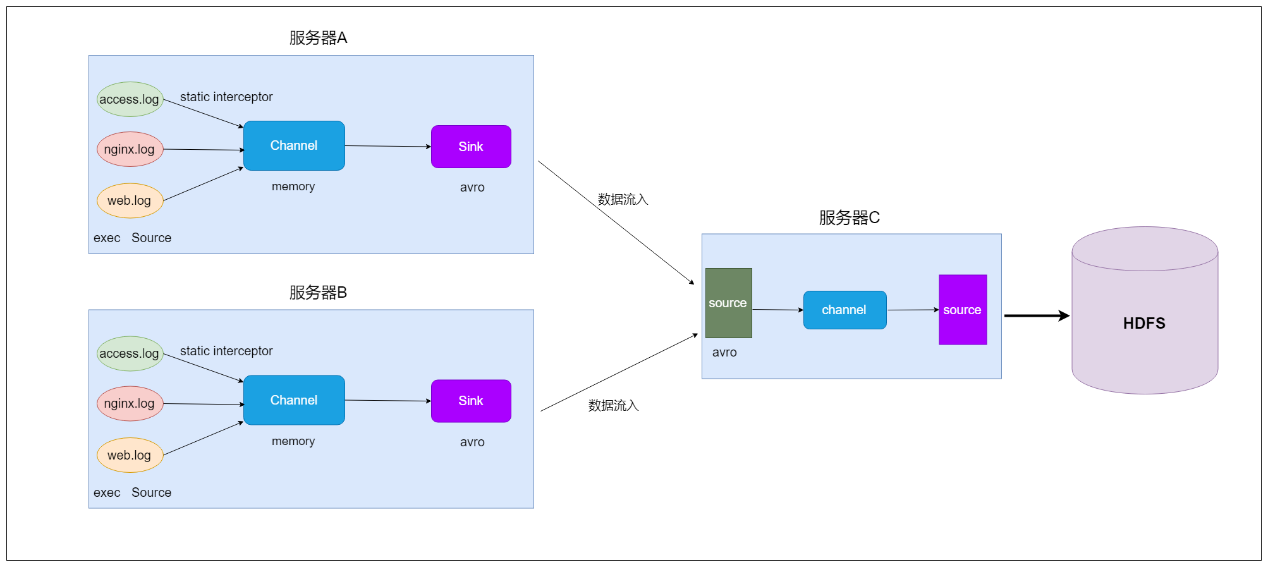Flume综合案例之静态拦截器使用
1. 案例场景
-
A、B两台日志服务机器实时生产日志主要类型为access.log、nginx.log、web.log
-
现在需要把A、B 机器中的access.log、nginx.log、web.log 采集汇总到C机器上然后统一收集到hdfs中。
-
但是在hdfs中要求的目录为:
|
1 2 3 |
/source/logs/access/20200210/** /source/logs/nginx/20200210/** /source/logs/web/20200210/** |
2. 场景分析

3. 数据流程处理分析

4. 实现
-
服务器A对应的IP为 192.168.52.100
-
服务器B对应的IP为 192.168.52.110
-
服务器C对应的IP为 192.168.52.120
采集端配置文件开发
- node01与node02服务器开发flume的配置文件
|
1 2 |
cd /kkb/install/apache-flume-1.9.0-bin/conf/ vim exec_source_avro_sink.conf |
- 内容如下
|
1 2 3 4 5 6 7 8 9 10 11 12 13 14 15 16 17 18 19 20 21 22 23 24 25 26 27 28 29 30 31 32 33 34 35 36 37 38 39 40 41 42 43 |
# Name the components on this agent a1.sources = r1 r2 r3 a1.sinks = k1 a1.channels = c1 # set source a1.sources.r1.type = exec a1.sources.r1.command = tail -F /kkb/install/taillogs/access.log a1.sources.r1.interceptors = i1 a1.sources.r1.interceptors.i1.type = static ## static拦截器的功能就是往采集到的数据的header中插入自定义的key-value对;与node03上的agent的sink中的type相呼应 a1.sources.r1.interceptors.i1.key = type a1.sources.r1.interceptors.i1.value = access a1.sources.r2.type = exec a1.sources.r2.command = tail -F /kkb/install/taillogs/nginx.log a1.sources.r2.interceptors = i2 a1.sources.r2.interceptors.i2.type = static a1.sources.r2.interceptors.i2.key = type a1.sources.r2.interceptors.i2.value = nginx a1.sources.r3.type = exec a1.sources.r3.command = tail -F /kkb/install/taillogs/web.log a1.sources.r3.interceptors = i3 a1.sources.r3.interceptors.i3.type = static a1.sources.r3.interceptors.i3.key = type a1.sources.r3.interceptors.i3.value = web # set sink a1.sinks.k1.type = avro a1.sinks.k1.hostname = node03 a1.sinks.k1.port = 41415 # set channel a1.channels.c1.type = memory a1.channels.c1.capacity = 20000 a1.channels.c1.transactionCapacity = 10000 # Bind the source and sink to the channel a1.sources.r1.channels = c1 a1.sources.r2.channels = c1 a1.sources.r3.channels = c1 a1.sinks.k1.channel = c1 |
服务端配置文件开发
- 在node03上面开发flume配置文件
|
1 2 |
cd /kkb/install/apache-flume-1.9.0-bin/conf/ vim avro_source_hdfs_sink.conf |
- 内容如下
|
1 2 3 4 5 6 7 8 9 10 11 12 13 14 15 16 17 18 19 20 21 22 23 24 25 26 27 28 29 30 31 32 33 34 35 36 37 38 39 |
# Name the components on this agent a1.sources = r1 a1.sinks = k1 a1.channels = c1 #定义source a1.sources.r1.type = avro a1.sources.r1.bind = node03 a1.sources.r1.port =41415 #定义channels a1.channels.c1.type = memory a1.channels.c1.capacity = 20000 a1.channels.c1.transactionCapacity = 10000 #定义sink a1.sinks.k1.type = hdfs a1.sinks.k1.hdfs.path=hdfs://node01:8020/source/logs/%{type}/%Y%m%d a1.sinks.k1.hdfs.filePrefix =events a1.sinks.k1.hdfs.fileType = DataStream a1.sinks.k1.hdfs.writeFormat = Text #时间类型 a1.sinks.k1.hdfs.useLocalTimeStamp = true #生成的文件不按条数生成 a1.sinks.k1.hdfs.rollCount = 0 #生成的文件按时间生成 a1.sinks.k1.hdfs.rollInterval = 30 #生成的文件按大小生成 a1.sinks.k1.hdfs.rollSize = 10485760 #批量写入hdfs的个数 a1.sinks.k1.hdfs.batchSize = 10000 #flume操作hdfs的线程数(包括新建,写入等) a1.sinks.k1.hdfs.threadsPoolSize=10 #操作hdfs超时时间 a1.sinks.k1.hdfs.callTimeout=30000 #组装source、channel、sink a1.sources.r1.channels = c1 a1.sinks.k1.channel = c1 |
采集端文件生成脚本
- 在node01与node02上面开发shell脚本,模拟数据生成
|
1 2 |
cd /kkb/install/shells vim server.sh |
- 内容如下
|
1 2 3 4 5 6 7 8 |
#!/bin/bash while true do date >> /kkb/install/taillogs/access.log; date >> /kkb/install/taillogs/web.log; date >> /kkb/install/taillogs/nginx.log; sleep 0.5; done |
- node01、node02给脚本添加可执行权限
|
1 |
chmod u+x server.sh |
顺序启动服务
- node03启动flume实现数据收集
|
1 2 |
cd /kkb/install/apache-flume-1.9.0-bin/ bin/flume-ng agent -c conf -f conf/avro_source_hdfs_sink.conf -name a1 -Dflume.root.logger=DEBUG,console |
- node01与node02启动flume实现数据监控
|
1 2 |
cd /kkb/install/apache-flume-1.9.0-bin/ bin/flume-ng agent -c conf -f conf/exec_source_avro_sink.conf -name a1 -Dflume.root.logger=DEBUG,console |
- node01与node02启动生成文件脚本
|
1 2 |
cd /kkb/install/shells sh server.sh |
- 查看hdfs目录
/source/logs
Flume综合案例之自定义拦截器使用
案例需求:
- 在数据采集之后,通过Flume的拦截器,实现将无效的JSON格式的消息过滤掉。
实现步骤
第一步:创建maven java工程,导入jar包
|
1 2 3 4 5 6 7 8 9 10 11 12 13 14 15 16 17 18 19 20 21 22 23 24 25 26 27 28 29 30 31 32 33 34 35 36 37 38 39 40 41 42 43 44 45 46 47 48 49 50 51 52 |
<dependencies> <dependency> <groupId>org.apache.flume</groupId> <artifactId>flume-ng-core</artifactId> <version>1.9.0</version> </dependency> </dependencies> <build> <plugins> <plugin> <groupId>org.apache.maven.plugins</groupId> <artifactId>maven-compiler-plugin</artifactId> <version>3.0</version> <configuration> <source>1.8</source> <target>1.8</target> <encoding>UTF-8</encoding> <!-- <verbal>true</verbal>--> </configuration> </plugin> <plugin> <groupId>org.apache.maven.plugins</groupId> <artifactId>maven-shade-plugin</artifactId> <version>3.1.1</version> <executions> <execution> <phase>package</phase> <goals> <goal>shade</goal> </goals> <configuration> <filters> <filter> <artifact>*:*</artifact> <excludes> <exclude>META-INF/*.SF</exclude> <exclude>META-INF/*.DSA</exclude> <exclude>META-INF/*.RSA</exclude> </excludes> </filter> </filters> <transformers> <transformer implementation="org.apache.maven.plugins.shade.resource.ManifestResourceTransformer"> <mainClass></mainClass> </transformer> </transformers> </configuration> </execution> </executions> </plugin> </plugins> </build> |
第二步:自定义flume的拦截器
新建package
com.niit.flume.interceptor新建类及内部类,分别是
JsonInterceptor、MyBuilder
|
1 2 3 4 5 6 7 8 9 10 11 12 13 14 15 16 17 18 19 20 21 22 23 24 25 26 27 28 29 30 31 32 33 34 35 36 37 38 39 40 41 42 43 44 45 46 47 48 49 50 51 52 53 54 55 56 57 58 59 60 61 62 63 64 65 66 67 68 69 70 71 72 73 74 75 76 77 78 79 80 81 82 83 84 85 86 87 88 89 90 91 92 93 94 95 96 97 98 99 100 101 |
package com.niit.flume.interceptor; import org.apache.commons.codec.Charsets; import org.apache.commons.lang.StringUtils; import org.apache.flume.Context; import org.apache.flume.Event; import org.apache.flume.interceptor.Interceptor; import org.slf4j.Logger; import org.slf4j.LoggerFactory; import java.util.ArrayList; import java.util.List; import java.util.Map; /** * @Author: deLucia * @Date: 2021/6/2 * @Version: 1.0 * @Description: */ public class JsonInterceptor implements Interceptor { private static final Logger LOG = LoggerFactory.getLogger(JsonInterceptor.class); private String tag = ""; public JsonInterceptor(String tag) { this.tag = tag; } @Override public void initialize() { } /** * 过滤JSON格式之外的数据 {“key":value, {...}} * @param event * @return */ @Override public Event intercept(Event event) { String line = new String(event.getBody(), Charsets.UTF_8); line = line.trim(); if (StringUtils.isBlank(line)) { return null; } // {..} if (line.startsWith("{") && line.endsWith("}")) { Map<String, String> headers = event.getHeaders(); headers.put("tag", tag); return event; } else { LOG.warn("Not Valid JSON: " + line); return null; } } @Override public List<Event> intercept(List<Event> list) { List<Event> out = new ArrayList<Event>(); for (Event event : list) { Event outEvent = intercept(event); if (outEvent != null) { out.add(outEvent); } } return out; } @Override public void close() { } /** * 相当于自定义Interceptor的工厂类 * 在flume采集配置文件中通过指定该Builder来创建Interceptor对象 * * @author */ public static class MyBuilder implements Interceptor.Builder { private String tag; @Override public void configure(Context context) { //从flume的配置文件中获得拦截器的“tag”属性值 this.tag = context.getString("tag", "").trim(); } /* * @see org.apache.flume.interceptor.Interceptor.Builder#build() */ @Override public JsonInterceptor build() { return new JsonInterceptor(tag); } } } |
第三步:打包上传服务器
- 将我们的拦截器打成jar包放到主机名为hadoop100的服务器上的flume安装目录下的lib目录下
第四步:开发flume的配置文件
开发flume的配置文件
|
1 2 |
cd /opt/pkg/flume/conf/ vim nc-interceptor-logger.conf |
- 内容如下
记得将下边的i1.type根据自己的实际情况进行替换
|
1 2 3 4 5 6 7 8 9 10 11 12 13 14 15 16 17 18 19 20 21 22 23 24 25 |
#声明三种组件 a1.sources = r1 a1.channels = c1 a1.sinks = k1 #定义source信息 a1.sources.r1.type=netcat a1.sources.r1.bind=localhost a1.sources.r1.port=8888 #定义source的拦截器 a1.sources.r1.interceptors = i1 #根据自定义的拦截器,相应修改全类名及内部类名 a1.sources.r1.interceptors.i1.type =com.niit.flume.interceptor.JsonInterceptor$MyBuilder ## tag的内容将被设置到消息头中 a1.sources.r1.interceptors.i1.tag = json_event #定义sink信息 a1.sinks.k1.type=logger #定义channel信息 a1.channels.c1.type=memory #绑定在一起 a1.sources.r1.channels=c1 a1.sinks.k1.channel=c1 |
第五步:运行FLume Agent
同时开启INFO日志级别
|
1 |
[hadoop@hadoop100 conf]$ bin/flume-ng agent -c conf/ -f conf/nc_interceptor_logger.conf -n a1 -Dflume.root.logger=INFO,console |
第六步:简单测试
通过netcat客户端发送数据
|
1 2 3 4 5 6 7 8 9 |
[hadoop@hadoop100 ~]$ nc localhost 8888 asd dsa {"OK OK { OK OK {"key":123} OK |
查看flume的agent的日志信息如下
|
1 2 3 4 5 6 7 |
2021-05-26 14:40:12,233 (lifecycleSupervisor-1-4) [INFO - org.apache.flume.source.NetcatSource.start(NetcatSource.java:155)] Source starting 2021-05-26 14:40:17,326 (lifecycleSupervisor-1-4) [INFO - org.apache.flume.source.NetcatSource.start(NetcatSource.java:166)] Created serverSocket:sun.nio.ch.ServerSocketChannelImpl[/127.0.0.1:8888] 2021-05-26 14:40:20,952 (netcat-handler-0) [WARN - com.niit.flume.interceptor.JsonInterceptor.intercept(JsonInterceptor.java:48)] Invalid json format event ! 2021-05-26 14:40:20,953 (netcat-handler-0) [WARN - com.niit.flume.interceptor.JsonInterceptor.intercept(JsonInterceptor.java:48)] Invalid json format event ! 2021-05-26 14:40:24,109 (netcat-handler-0) [WARN - com.niit.flume.interceptor.JsonInterceptor.intercept(JsonInterceptor.java:48)] Invalid json format event ! 2021-05-26 14:40:24,909 (netcat-handler-0) [WARN - com.niit.flume.interceptor.JsonInterceptor.intercept(JsonInterceptor.java:48)] Invalid json format event ! 2021-05-26 14:40:36,895 (SinkRunner-PollingRunner-DefaultSinkProcessor) [INFO - org.apache.flume.sink.LoggerSink.process(LoggerSink.java:95)] Event: { headers:{tag=json_event} body: 7B 22 6B 65 79 22 3A 31 32 33 7D {"key":123} } |
Views: 108

